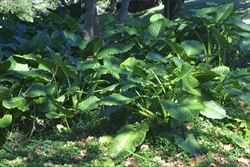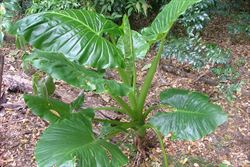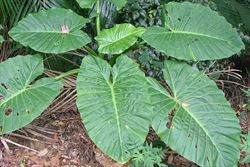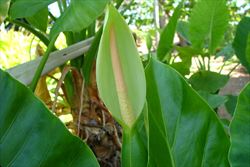Click on images to enlarge

infestation (Photo: Trevor James)

habit (Photo: Sheldon Navie)

leaves (Photo: Sheldon Navie)

flower cluster (Photo: Sheldon Navie)

immature fruit (Photo: Sheldon Navie)

mature fruit (Photo: Sheldon Navie)

old fruit (Photo: Sheldon Navie)

seedling (Photo: Sheldon Navie)
Scientific Name
Alocasia brisbanensis (F.M. Bailey) Domin
Synonyms
Alocasia macrorrhizos (L.) G. Don (misapplied)
Alocasia macrorrhizos (L.) G. Don var. brisbanensis F.M. Bailey
Alocasia macrorrhiza (L.) G. Don var. brisbanensis F.M. Bailey, orth. var.
Caladium glycorrhizon Fraser
Colocasia macrorrhizos (L.) Schott (misapplied)
Colocasia macrorrhizos (L.) Schott var. brisbanica F.M. Bailey
Colocasia macrorrhiza (L.) G. Don var. brisbanica F.M. Bailey, orth. var.
Family
Araceae
Common Names
alocasia, aroid lily, cunjevoi, cunjevoi lily, elephant ear, elephant ears, elephant's ears, native elephant ear, spoon lily
Origin
Native to the warmer coastal and sub-coastal districts of eastern Australia (i.e. in eastern Queensland and eastern New South Wales, north from the Illawarra region).
Naturalised Distribution
This species is naturalised in the coastal districts of south-western Western Australia. It is also naturalised in New Zealand.
Notes
Elephant ears (Alocasia brisbanensis) grows naturally as an understorey herb in rainforests and on rainforest margins in eastern Australia, where it is known as "cunjevoi". It has become popular in gardens in other parts of Australia because of its handsome foliage and ability to thrive in the shade. However, its brightly coloured fruit are poisonous to humans and its seeds are readily dispersed into bushland by birds.
Elephant ears (Alocasia brisbanensis) is regarded as a minor environmental weed in Western Australia and as a potential environmental weed in Victoria. This species is currently of concern as a weed of waterways in the south-western parts of Western Australia. It grows in drainage lines at Albany, presumably persisting and spreading from dumped garden waste.
In New Zealand, elephant ears (Alocasia brisbanensis) is an emerging weed of wetlands, riparian areas, heavily disturbed shrublands and forests, damp frost-free open areas and old pastures.
Note: Until recently, elephant ears (Alocasia brisbanensis) was confused with another very similar plant (i.e. Alocasia macrorrhizos) that is native to south-eastern Asia. Alocasia macrorrhizos has only been recorded for Australia from the Murray Islands, in the Torres Strait, where it is regarded as being native. However, it may be present in cultivation in other parts of Australia.

